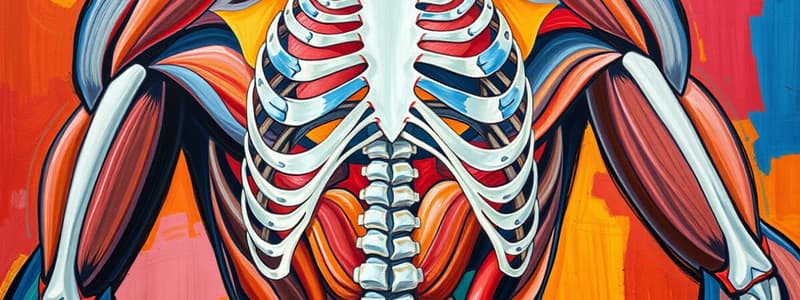Podcast
Questions and Answers
What is the primary role of skeletal muscles in respiration?
What is the primary role of skeletal muscles in respiration?
Help us breathe
Which of the following is NOT a function of the muscular system?
Which of the following is NOT a function of the muscular system?
- Respiration
- Maintenance of posture
- Production of hormones (correct)
- Movement of the body
What are the three types of muscular fascia?
What are the three types of muscular fascia?
Epimysium, Perimysium, Endomysium
Cardiac muscles help propel food in the gastrointestinal tract.
Cardiac muscles help propel food in the gastrointestinal tract.
What ability allows muscles to shorten forcibly?
What ability allows muscles to shorten forcibly?
What is the role of neuromuscular junctions?
What is the role of neuromuscular junctions?
The plasma membrane of muscle fibers is called the ______.
The plasma membrane of muscle fibers is called the ______.
What do myofibrils do?
What do myofibrils do?
Titin is a protein that gives muscle the ability to stretch and recoil.
Titin is a protein that gives muscle the ability to stretch and recoil.
Match each type of muscle with its primary function:
Match each type of muscle with its primary function:
Flashcards are hidden until you start studying
Study Notes
Functions of the Muscular System
- Enables body movement through skeletal muscles; includes actions such as walking and running.
- Maintains posture by keeping skeletal muscles toned for position stability.
- Facilitates respiration with the thoracic and diaphragm muscles aiding in breathing.
- Generates body heat via muscle contractions to help regulate body temperature.
- Supports communication through actions like speaking, writing, and smiling.
- Smooth muscles constrict organs and vessels, aiding digestion and blood circulation.
- Cardiac muscle contraction propels blood throughout the body.
General Properties of Muscles
- Contractility: Ability to shorten forcefully during contraction.
- Excitability: Capability to respond to stimuli.
- Extensibility: Capacity to be stretched without injury.
- Elasticity: Ability to return to original length after being stretched.
Connective Tissue Covering
- Fascia: Connective tissue sheets located between muscles and skin.
- Epimysium: Dense connective tissue encasing entire muscles.
- Perimysium: Tissue surrounding muscle fiber groups called fascicles.
- Endomysium: Fine connective tissue sheath enveloping each muscle fiber.
Nerves and Blood Vessels
- Connective tissue provides pathways for nerves and blood vessels.
- Motor Neurons: Specialized cells that stimulate muscle contractions; originate from the brain and spinal cord.
- Neuromuscular Junctions: Contacts between motor neuron axons and muscle fibers.
- Arteries and veins accompanying nerves supply muscle tissues.
Skeletal Muscle Fiber
- Develop from myoblasts during growth.
- Fibers range from 1mm to 4cm in length, with some reaching 30cm.
- Muscle fiber quantity stabilizes post-birth, increasing in size through hypertrophy.
Components of Muscle Fibers
-
Electrical Components:
- Sarcolemma: The plasma membrane of muscle fibers.
- Transverse Tubules: Tubular extensions of the sarcolemma, conducting electrical impulses.
- Sarcoplasmic Reticulum: Specialized smooth endoplasmic reticulum storing calcium for muscle contraction.
-
Mechanical Components:
- Myofilaments:
- Actin Myofilament: Thin filament involved in contraction.
- Myosin Myofilament: Thick filament, interacts with actin during contraction.
- Myofibrils: Bundles of myofilaments functioning together during muscle contraction.
- Sarcomeres: Basic units of skeletal muscles, the smallest segment capable of contraction.
- Myofilaments:
Sarcomeres Structure
- Z Disks: Anchor points for actin myofilaments.
- I Bands: Light areas containing only actin myofilaments.
- A Band: Central, darker areas that have both actin and myosin, excluding the very center.
- H Zone: Middle part of the A band containing only myosin myofilaments.
- M Zone: Center area of the H zone stabilizing myofilaments.
- Titin: Large protein providing muscles the ability to stretch and recoil.
Myofilament Structures
- Actin Myofilament: Composed of globular actin (G-actin) molecules that form strands.
- Myosin Myofilament: Composed of elongated molecules essential for muscle contraction.
Studying That Suits You
Use AI to generate personalized quizzes and flashcards to suit your learning preferences.




